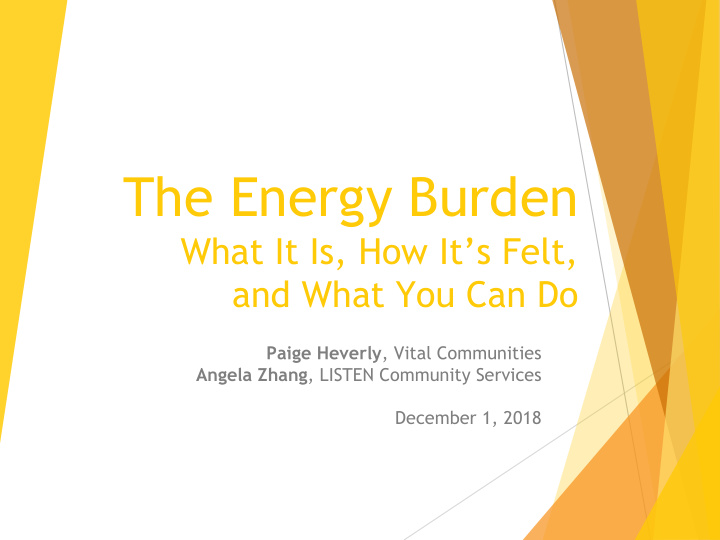



The Energy Burden What It Is, How It’s Felt, and What You Can Do Paige Heverly , Vital Communities Angela Zhang , LISTEN Community Services December 1, 2018
What do we mean by “ energy burden ”?
It’s increasing. VLS Report . Energy Costs and Burdens in Vermont: Burdensome for Whom? Data from the Census Bureau’s American Community Survey
It’s disproportionate. Percentage of households spending more than 10% of income on energy costs VLS Report . Energy Costs and Burdens in Vermont: Burdensome for Whom? Data from the Census Bureau’s American Community Survey
It has real effects.
Exacerbated by outside factors
Energy prices are increasing Change in real price of energy source, 2000 - 2012 VLS Report . Energy Costs and Burdens in Vermont: Burdensome for Whom? Data from the Census Bureau’s American Community Survey
What assistance is available?
Low Income Home Energy Assistance Program (LIHEAP) Run by the Department of Health and Human Services Administered differently in each state FY19 budget of $3.69 billion Vermont FY19 Funding : $20,446,280 Eligibility: 150% Federal Poverty Level (HH1: $18,210, HH4: $37,650) or 60% state median income (HH1: $31,786) Benefits: Heating: $21 minimum, $1,537 maximum Crisis: $644 maximum Households served FY16: Heating: 21,563 Crisis: 2,948
Weatherization Assistance Program (WAP) Part of the Department of Energy Administered differently in each state. Vermont 2016 Funding : $1,228,156 Vermont 2017 Funding : $1,300,807 Vermont 2018 Funding : $1,435,939 Eligibility: 150% Federal Poverty Level (HH1: $18,210, HH4: $37,650) Benefits: Heating: $21 minimum, $1,537 maximum Crisis: $644 maximum Households served FY16: Heating: 21,563 Crisis: 2,948
Vermont Energy Assistance Resources “The CAP map”
How is assistance administered? Fuel Assistance Electric Assistance Crisis Fuel Assistance Weatherization Assistance Local assistance resources
What is Fuel Assistance? It helps pay for heat ● Available between November and April ● Benefit is paid to the fuel supplier once a household is approved ● Recipients must reapply each year - renewal forms are automatically sent ● Sometimes called “supplemental” or “seasonal” fuel assistance ● Income eligibility: 185% of FPL (HH1: $1872/month, HH4: $3870/month) ● Available to homeowners and renters (even if heat is included in rent) ● Amount based on client need ● Applications begin in July for priority households - better to apply early ● Apply online, in person, or via mail
What is Electric Assistance? It helps pay for electricity Available year-round Eligibility: 150% of Federal Poverty Level and residential customer of GMP Can help with: 25% discount off the monthly charges for energy used Arrears forgiveness if customer new to the program and owes on a past bill Partial arrears forgiveness (50% of bill) if customer is currently enrolled in the program and owes on a past bill.
What is Crisis Fuel? It helps pay for emergency heat Income eligibility: 200% of Federal Poverty Level; must also demonstrate crisis need Can be used to Purchase the primary source of your heat (e.g., electricity, kerosene, natural gas, oil, propane, or wood) Purchase electricity if it's required to run your heating system Have your furnace repaired or replaced Negotiate payment plans Work with your electric or natural gas company to prevent disconnection Can apply starting last week of November through April
What is Weatherization Assistance? It pays for air sealing and insulation upgrades Eligible if: Household income is at or below 80% AMI (<60% AMI prioritized) ● Someone in household receives Supplemental Security Income ● Someone in household receives Fuel Assistance ● Someone received fuel assistance last winter and is still eligible ● Someone in household is approved for fuel assistance this winter ● May include: Whole house assessment of energy-related problems ● Diagnostics including energy audit, infrared imaging, carbon ● monoxide, and heating efficiency testing Energy efficiency retrofits: insulation, air sealing, and heating ● system upgrades and replacements Apply through local CAP agency (refer to CAP map) Often have long waitlists - get on the waitlist!
Drawbacks & Barriers LIHEAP - $3.65 billion appropriated for FY19 (similar in FY18) WAP - $224 million for FY17 WAP - $215 million for FY16 WAP - $191.8 million for FY15 Short-term versus long-term need Poverty is complex and energy burden is one piece of the puzzle Systemic factors
What can you do? Get to know Your CAP Agency and other local resources Model-sharing and having conversations Energy Advocacy Council Raising Public Awareness Incorporate the perspectives & lived experiences of people in poverty into your work
Discussion With 2-4 people sitting close by, talk about: What could your role be as a Vermonter or an Energy Committee member be in alleviating the energy burden? What are the other communities you are involved in? How can you bring this knowledge to them? What organizations in your region might you partner with? What are your unique skills that can help you can move this issue forward? What do you need in order to be successful?
Report out Share your ideas with the rest of the group
QUESTIONS?
Thank you! Angela Zhang Programs Director LISTEN Community Services angela@listencs.org Paige Heverly Energy and Transportation Coordinator Vital Communities paige@vitalcommunities.org
Recommend
More recommend